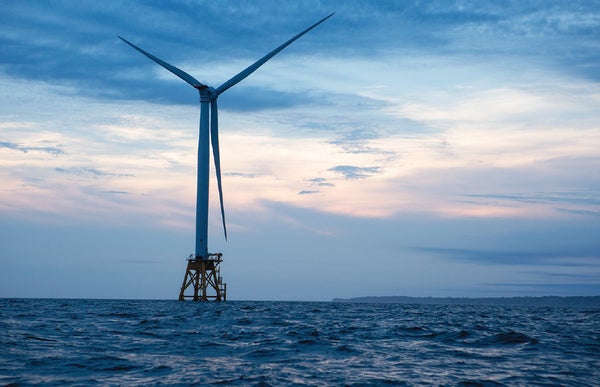The first offshore wind farm in the U.S. is scheduled to begin operations this month off the coast of Rhode Island—a small but notable step forward, given that other offshore projects have run into stiff headwinds this side of the Atlantic. The five turbines that make up the Block Island Wind Farm will generate 30 megawatts of electricity—enough to power 17,000 homes on average.
It is a surprise (and frustration) to many that the facilities have not cropped up sooner, considering the potential that offshore wind has to reduce long-term dependence on fossil fuels—and to add new power options for coastal cities with limited real estate. In fact, offshore wind has taken off in Europe, with an installed capacity of 11.5 gigawatts.* Analysts put the U.S.'s potential at more than 2,000 gigawatts, which is almost double the current electricity use in this country. Yet efforts to launch offshore wind power have fallen short for myriad reasons. For one, electricity distributors have had little reason to pay the higher costs compared with cheaper onshore power sources, such as natural gas and hydroelectric plants. “There is a graveyard of U.S. offshore wind projects that have died after failing to secure a contract for the purchase of its electricity,” says Alex Morgan, a wind energy analyst at Bloomberg New Energy Finance. It does not help that developers currently have to import expensive turbines from Europe or Asia because there is not a homegrown supply chain.
Similar financing challenges stalled Cape Wind, a project that envisioned 130 wind turbines off the coast of Cape Cod, Mass. That project also struggled against lawsuits by fishers, environmentalists and residents who did not want the structures to obstruct their view.
On supporting science journalism
If you're enjoying this article, consider supporting our award-winning journalism by subscribing. By purchasing a subscription you are helping to ensure the future of impactful stories about the discoveries and ideas shaping our world today.
Deepwater Wind, the developer of the Block Island Wind Farm, minimized political opposition and financing costs by starting small, but it hopes to eventually build a 15-turbine, 90-megawatt offshore facility 30 miles southeast of Montauk on Long Island. Other efforts suggest that Block Island won't be alone for long. For instance, the state of Massachusetts recently signed an energy bill that requires the purchase of offshore wind power if facilities are built. That mandate, combined with existing offshore wind leases, could lead to 1.6 gigawatts of offshore wind power being produced by 2024, according to Bloomberg New Energy Finance. The Department of Energy has also dedicated an extra $40 million each for projects located near Maine and New Jersey and in Lake Erie.
If nothing else, the impending retirement of old coal, oil and nuclear power plants opens the door for offshore wind farms, says Jeff Grybowski, CEO of Deepwater Wind. But everything comes down to the competitiveness of this energy option in U.S. markets. “The chicken-and-egg game begins when a new market such as the U.S. will only build offshore wind if the price is not too high,” Morgan says.
*Editor's Note (11/21/16): This sentence from the print article was edited after it was posted online. The original erroneously stated the 11.5-gigawatt figure as offshore wind's annual production, rather than its capacity.
